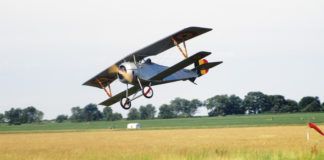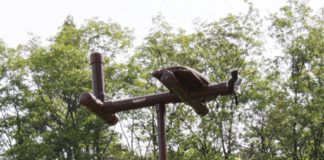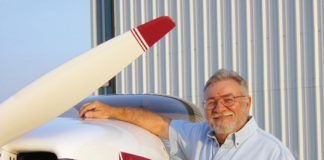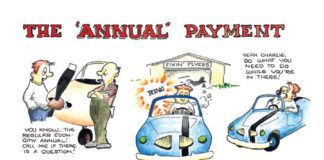Unless you’re building something with a classic look and feel-an aircraft that demands round instruments-you probably have some type of EFIS in your future. Increasing reliability combined with decreasing cost of non-certified units make the decision to go digital for flight instruments a no-brainer for most projects. The problem is: Which system do you choose? (Nice problem to have.)
As regular KITPLANES readers know from reading Stein Bruchs EFIS roundup in the May issue, the number of choices is staggering. So, rather than attempt an all-encompassing review-its pretty difficult to get the 10 manufacturers wares into one airplane at one time-well look at two systems we flew in virtually identical aircraft and discuss how you might evaluate four key aspects to determine if a particular system is right for you.
The specimens under the microscope are the Dynon EFIS-D100 and the TruTrak EFIS. Both were flown in Remos GX LSAs supplied by Frank Maslakow of Sierra Foxtrot Aviation in Fort Smith, Arkansas, and Tommy Lee of Adventure Flight, in Springdale, Arkansas. (Pay no attention to the fact that were talking about ready-to-fly LSAs; these instrument packages are the same as those you could buy for your homebuilt.)
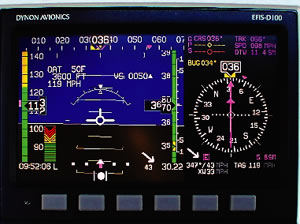
Thats quite a wind-correction angle you’re going to need there, Van West. An intelligent HSI layout presents everything but the map from the GPS doing the driving.
Performance You Can Bank On
The core consideration is how far you can trust the system. Even certified glass isn’t failure free. The good news is that most systems rate well, but there’s something to be said for choosing a product thats been in the field and had time to fail on someone elses panel. Dynon D100s have thousands of hours in service under all sorts of conditions-hot, cold, high-altitude, hard IFR, bolstered by as many hours with the sensor- and software-similar small-screen EFIS-D10A. TruTraks EFIS has far fewer installations, but the company has a reputation for quality equipment, and some of the EFIS stands on technology thats come before.
Both certified and non-certified systems rely on small rate sensors and accelerometers that are, essentially, the same equipment. The big difference is how they verify and supplement the data coming from these sensors. Garmin uses movement through the magnetic lines of the earth, 3D GPS position changes, airspeed and static pressure, to come up with its full solution for aircraft attitude in its G1000. But both Dynon and TruTrak simply use rate sensors plus airspeed.
The simple solution works well in normal flight conditions, but airspeed-only aiding of the system can create false pitch changes with acceleration and deceleration. We tried to get both systems to misbehave in the Remos and saw only small, momentary misinformation when we tried hard and watched closely. This may be because the Remos just cant accelerate fast enough, and its long pitot tube kept things squared away even in highly uncoordinated flight.
The point here, however, is that performance with these EFISes is highly dependent on the accuracy of your pitot-static setup in a variety of flight conditions. You should also see if you can fly, or get reports of, the system in aircraft of similar performance to what you’re building. High-performance acceleration may mean much more significant erroneous pitch indications. We saw good performance from both systems in turbulence, but have heard from some Dynon users that the thin lines get hard to read when the bumps are nasty.
Be sure to take a look at how the systems display errors. Total loss of attitude is usually met with big red Xs, but other failures could be more subtle. For example, the TruTrak uses GPS to show ground track instead of heading (more on that in a moment). If the GPS signal is lost, a small No GPS text appears by the HSI (horizontal situation indicator). The text is white and subtle, even though the HSI is now working like a traditional directional gyro thats subject to drift and must be periodically reset to match the whiskey compass.
No matter how good the displays are, plan on some backup attitude source if you fly IFR, even if its a second EFIS.
The Right User Interface
Once you’re happy with reliability, the real fun begins. Your satisfaction with the EFIS will largely be based on what those pretty pixels show you.
The Dynon D100 display can be packed with information. This means it can also get really busy. The display has standard airspeed and altitude tapes on the left and right and a full-screen horizon. Heading is shown across the top of the display, which is troubling for some pilots. A powerful split-screen feature can fix this by showing both attitude and an excellent HSI.
Some aspects of the D100 user interface excel. Smart visual stacking of elements on the HSI and heading strip means the bugs for GPS ground track, course and heading are all viewable at all times (Garmin, are you listening?). You can get on-course guidance in any wind by knowing what to line up where. An optional angle of attack indicator is in easy view, and the system has clear warnings for things like low or high airspeed, departing the bugged altitude and more. You can add data blocks with everything from G-meter outputs to GPS information in the blue sky area.
The D100 is controlled through several levels of menus driven by buttons below the display. This is fine for setting up datablocks to your liking, but its awkward for setting bugs or courses. Wed highly recommend the $650 HS34 add-on for better control of the D100. The HS34 does far more than youd guess from just playing around with it. Getting the most from Dynon requires reading the documentation (which is excellent, by the way). One further plus of the D100 is a built-in battery backup.
The D100 graphics quality is adequate, but not what youd call high res. (Dynon knows this, and the next-generation boxes will have significantly improved resolution.) Small text for some data and thin lines are harder to read than the TruTrak or other systems we’ve looked at. For an RV-4, where the display is close to your face, this may be a non-issue, even if you’re a member of the bifocal club. Build something with more stretching room, and the cool D100 extras of track and tuned frequency may be too small to read.
TruTraks beautiful display is almost the other end of the spectrum. The anti-aliased graphics scroll with fluidity on par with a certified EFIS. Numbers and letters are large, well placed and easy to read. For example, the waypoint and distance information are just above and to the sides of the HSI.
But the TruTrak isn’t showing exactly what youd expect. Its EFIS horizon shows vertical speed, not attitude. Put the aircraft symbol on the horizon, and you’re holding altitude. It works whether you’re really 7 nose down in cruise flight or 10 nose up in slow flight. There is an option to show traditional attitude.
To guard against a stall, TruTrak flashes the airspeed pointer if you get too slow. If you have the flight director visible, it will flash red and command a nose-down path to hold airspeed at a user-specified setting. We tried it, and the warning would be hard to miss.
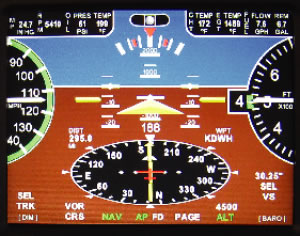
For traditionalists, the TruTrak can be switched to attitude mode, where the horizon line represents pitch angle.
The other non-obvious oddity about the TruTrak EFIS is that the heading shown on the HSI is actually GPS-derived ground track. Nowhere on the TruTrak EFIS does it show aircraft heading. Jim Younkin of TruTrak argues that all a pilot really cares about in almost all flight conditions is vertical speed and track anyway-those are what get you where you want to go. Want to fly the 154 localizer inbound? Fly 154 on the HSI, and all wind correction is automatically accounted for. After 10 hours of using the TruTrak in local and cross-country flying, we have to say that it works well. The EFIS is easy to fly and a pleasure to look at. The only time we got confused for a moment on heading/track was maneuvering to a runway at night with a strong wind.
In all but the bottom-end TruTrak system, the autopilot is integrated into the EFIS and can maintain a track (set with a bug just like a heading bug) or follow a GPS course. Control couldn’t be simpler: Toggle the autopilot on and off with one button, and switch between GPS and track with another. Toggle the optional flight director on with a third button. The autopilot can also follow VOR or localizer signals, though the buttonology for this is a bit convoluted. Options for the autopilot include a Level button that will roll the wings level and hold altitude, similar to the level button in a Cirrus Perspective. You can even get a yaw damper.
Another unique feature is that the airspeed and altitude wheels rotate, but the pointer stays still. The advantage is you can detect even the slightest motion immediately. This helps maintain an altitude or airspeed. But reading the actual numeric value is no easier than with tapes, in our view.
We really liked the critical engine information across the top of the EFIS, right in our regular visual scan. It also changes color to warn the pilot of an issue. Other great features of the TruTrak system are flap and trim position indicators that appear on screen when you need them, easy reconfiguration of the display, and engine and flight-time information on the primary display. TruTrak can give you guidance to an approximate final approach for any airport and any runway. (It lines you up with the airport center on the correct heading for the runway, which is why its approximate.) Its pretty slick, but having a moving map makes the feature somewhat superfluous.
This system is easy to use and we found only two features that required real explanation to use correctly. In fact, the downloadable manual is only two pages long-including the cover page. (The Dynon D100 manual is 86 pages.)
There are some annoyances with the system. The altitude bug sets at 500-foot increments only, which makes setting pattern altitude impossible at many airports. Wed also like to see a display of instantaneous winds aloft on the primary display.
Plays Well with Others
Be sure the system will integrate well with other components you plan to install. For example, the TruTrak EFIS can take ARINC-429 inputs, which let the autopilot fly procedure turns and holds, and provides more accurate tracking on approaches. The D100 can also do this, but only through an optional add-on such as the HS34. (With this module, the D100 can actually share ARINC-429 data bi-directionally with some GPSes.) Natively-without the HS34, that is-the D100 can also take RS-232 serial data from most popular GPS units and the Garmin SL 30 nav/com. If you have a Garmin 430, for example, and you want to see the ILS and VOR information on the D100, you’ll need the HS34.
The Dynon D120 engine display exchanges data with the D100 via a common bus. This makes integration simpler and lets you get backup flight instruments on the second display. But its not really a backup, as it relies on the D100 for that data. Thats why some homebuilders are using the FlightDEK-D180 combined EFIS/engine monitor as the primary, with a D100 or D10A as a backup attitude/pitot-static source. TruTraks engine instrument display has optional, independent backup instruments built in.
Growth potential? For the Dynons, you can add the company’s recently released autopilot servos, but don’t expect the D100/D10A/D180 architecture to expand much beyond its current form. Mike Schofield of Dynon told us the system is about maxed out on what it can display. Dynon has plans for an entirely new system with moving maps and synthetic vision on new hardware to be released next year. The company hasnt committed to a trade-in value for upgrading customers, but said it could be as much as a 50% discount. Dynon has an excellent web site, and we’ve heard accolades for its customer support.
TruTraks system has room to grow, but given Younkins philosophy of exactly the information you need and no more, wed expect small improvements but no major changes to existing products in the foreseeable future.
A Price You Can Abide
No matter which system you like best, the wallet impact cant be ignored. Dynons comparatively low cost is hard to beat. The D100 is $2400, and the accompanying D120 engine monitor is $2000 (probes not included). For space-challenged cockpits, the Dynon D180 combines these units into one for $3200. The HS34 is $650 extra and is needed to approach TruTraks ease of use. If you opt for the autopilot, plan on spending at least the $450 to get the AP74 module, which will also improve the D-series ergonomics because it has a Value knob. However, this configuration does not support ARINC-429 data buses or analog resolvers, as does the HS34. You might find yourself needing both the AP74 and the HS34. A full-house, two-axis-autopilot D100/D120 combo (sans probes, which vary in price depending on the engine) with the AP74 and HS34 will set you back $7000.
The TruTrak system is priced higher. The basic EFIS is $3800, and the engine monitor is $2200 ($2700 with backup instruments). Add a single-axis autopilot, and the EFIS alone is $5300. Dual-axis autopilot/EFIS units range from $6700 to $8900 depending on how sophisticated a system you want. At press time, the Dynon autopilot system is roughly on par with TruTraks EFIS AP III ($7200), putting the combined cost (EFIS and engine monitor) at $9400. Incidentally, both companies offer brighter displays. For the Dynons, add $200 per box; TruTraks upgrade is $500 per display.
So Who Wins?
With these criteria in mind, you can make a more informed decision about what EFIS will work best for you. Whats our final take on these two systems? If you’re a feature geek who likes flying in a sea of data, Dynon is the choice; info wonks can fairly choke the screen with digits and arrows and more. Plus, the Dynons remain value leaders, even if the systems themselves are nearing the end of their development cycle. Wed liken the Dynons to a PC-maybe not as elegant, but fully featured, inexpensive and open to plenty of under-the-hood customizing.
TruTrak is more like a Mac. Simple, beautiful graphical interface, mostly intuitive. After spending time with both systems, in the same type of aircraft, this distinction is clear: The philosophies that form both systems lend them dramatically different personalities. Performance is similar-excluding anything to do with the autopilot part of the equation-and both get the job done, just in different ways. So, ask yourself this question: Are you a Mac or a PC?
For more information, contact Dynon Avionics at 425/402-0433 or visit www.dynonavionics.com; contact TruTrak Flight Systems at 479/751-0250 or visit www.trutrakflightsystems.com.










